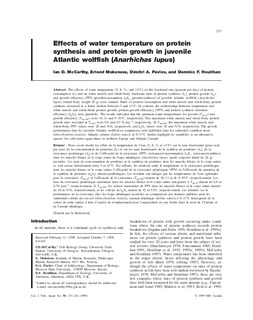Effects of water temperature on protein synthesis and protein growth in juvenile Atlantic wolffish (Anarhichas lupus)
Journal article, Peer reviewed
Permanent lenke
http://hdl.handle.net/11250/108274Utgivelsesdato
1999Metadata
Vis full innførselSamlinger
- Articles [3012]
Sammendrag
The effects of water temperature (5, 8, 11, and 14°C) on the fractional rate (percent per day) of protein
consumption (kr) and on white muscle and whole-body fractional rates of protein synthesis (ks), protein growth (kg),
and growth efficiency (PPV, growth/consumption; kg/ks, growth/synthesis) of juvenile Atlantic wolffish (Anarhichas
lupus) (initial body weight 26 g) were studied. Rates of protein consumption and white muscle and whole-body protein
synthesis increased in a linear fashion between 5 and 14°C. In contrast, the relationships between temperature and
white muscle and whole-body protein growth, protein growth efficiency (PPV) and protein synthesis retention
efficiency (kg/ks) were parabolic. The results indicated that the optimum water temperatures for growth (Topt.G) and
growth efficiency (Topt.GE) were 10–11 and 9–10°C, respectively. The maximum white muscle and whole-body protein
growth rates recorded at Topt.G were 0.9 and 0.7 %·day–1, respectively. At Topt.GE, the maximum white muscle and
whole-body PPV values were 28 and 34%, respectively, and kg/ks values were 92 and 51%, respectively. The growth
performance data for juvenile Atlantic wolffish in comparison with published data for salmonids (rainbow trout
(Oncorhynchus mykiss), Atlantic salmon (Salmo salar)) at 9–11°C further highlight its suitability as an alternative
species for cold-water aquaculture in northern Europe and Atlantic Canada.
